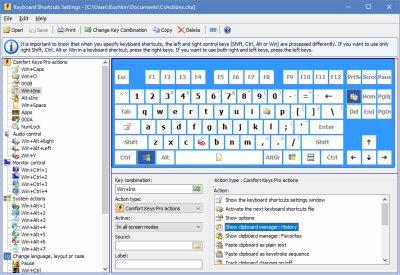Keyboard shortcuts settings
A keyboard shortcut (also known as accelerator key, shortcut key, hot key, hotkey, key binding, key combo, etc.) is a combination of keys that you need to press simultaneously to perform a certain action.
Keyboard shortcuts are added, deleted, and edited in the Keyboard Shortcuts Settings window. You can open it in several ways:
| 1. | Click the Comfort Keys Pro icon in the system tray. |
| 2. | Right-click the Comfort Keys Pro icon in the system tray to open the application’s context menu. Then select the Keyboard Shortcuts Settings item in that menu. |
| 3. | Press the keyboard shortcut that opens the Keyboard Shortcuts Settings window (by default, Win+CapsLock). |

NEXT STEP: Specify the keyboard shortcut to be used. There are two ways to do it:
| 1. | Switch to the Key combination field and press the desired key combination. |
| 2. | Use the mouse pointer to select the keys for the combination on the on-screen keyboard. |
NEXT STEP: Use the Action field to select the type of the action to be performed when you press the specified shortcut key.
You can use the Active field to specify display modes the specified action should work in. For instance, you can disable the Win keys and enable additional shortcut macros (see Play a keystroke macro section) in full-screen mode. This way, you can apply special settings when playing a computer game.
LAST STEP: Specify advanced parameters for the selected action. See the list of all actions, their parameters and usage examples in the Action types section.
Tips and tricks
| • | If you assign a label for an action, this label will be displayed on the on-screen keyboard and in the hint instead of the action description. |
| • | When specifying a keyboard shortcut, you can use almost any keys or key combinations, including NumLock, CapsLock, and Alt+Tab. However, the following keys and key combinations cannot be used: Sleep, WakeUp, Power, F-Lock, and Ctrl+Alt+Del. |
| • | When you are specifying keyboard shortcuts, the left and right control keys (Shift, Ctrl, Alt, or Win) are processed differently. To use only the right Shift, Ctrl, Alt, or Win key in a keyboard shortcut, press the respective right key. To use both right and left keys, press the respective left key. |
| • | To delete an earlier specified keyboard shortcut, select (None) in the Action type field. |
| • | To print the list of keyboard shortcuts, select the Print List item on the File menu. |
| • | If you create several files with different keyboard shortcut configurations, you will be able to switch between them at any time (for instance, to use a separate set of keyboard shortcuts for particular applications). You can activate the necessary keyboard shortcut set from the list of recently used keyboard shortcuts by selecting the Activate Keyboard Shortcuts File item in the application’s context menu. You can also specify and use a keyboard shortcut for switching between the files from the list in the context menu (by default, Win+O). |
| • | You can add a set of keyboard shortcuts from another file. To do it, select the Add from File... item on the File menu, and then select the file with the keyboard shortcut set. |
| • | You can add a set of standard keyboard shortcuts to your file. To do it, open the Settings dialog box, switch to the Keyboard Shortcuts section, and click the Add... button. You can also remove an existing set of standard keyboard shortcuts from your file by clicking the Remove... button in the same section. |
| • | To use one set of keyboard shortcuts in workgroups, save the file containing this set to a network resource, and configure it to be used on each workstation. |


